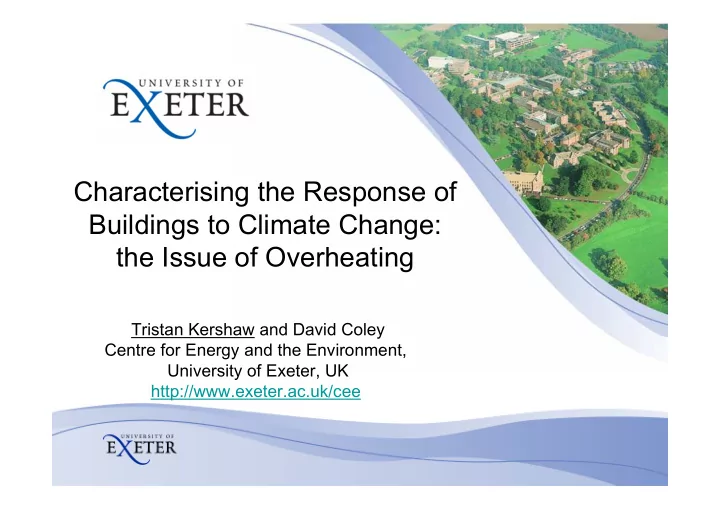

Characterising the Response of Buildings to Climate Change: the Issue of Overheating Tristan Kershaw and David Coley Centre for Energy and the Environment, University of Exeter, UK http://www.exeter.ac.uk/cee
•Given current climate predictions how do typical buildings fare? •Carbon emissions currently exceed UKCIP high emissions scenario. •What about the urban heat island effect? London is typically 1.5ºC warmer than surroundings. •Is there a need for extreme scenarios? Adapted from UKCP09
Morphing orphing What happens on the daily scale? Can morph existing weather files using climatic projections to produce ‘future’ weather years. Can morph twice to produce extreme or upper bound reference years. Creation of reference year type files allows whole building thermal simulation under different climatic conditions.
Buildings last a long time, there is a need to know how a certain design will fair over the coming decades. Whole building thermal simulations show that the number of hours of overheating increases significantly with time and more aggressive climate change projections.
•Thermal comfort of occupants is important. •What are the main driving factors associated with occupant comfort. •Not just comfort, also health implications, heat stress. •Paris, August 2003, 14,800 heat-related deaths. •Buildings need to not only moderate external temperatures but also cool effectively.
Climate change coefficient C T. •Allows architects to easily consider the •Linear response of a viability of different design to different designs amounts of climate. •Only two simulations •Simple metric are needed to characterised by external calculate C T rather air temperature. than one for each climate projection and •Robust to large changes time-slice. in weather patterns. •The internal •Allows architects to conditions of a building easily consider the can be estimated for viability of different any amount of climate designs. change. Coley D, Kershaw T. Changes in Internal Temperatures within the Built Environment as a Response to a Changing Climate, Building and Environment (2009), doi: 10.1016/ j.buildenv.2009.05.009
New buildings that overheat New buildings that overheat •Outdated reference weather years. Can cause new buildings to overheat. •Detailed simulations allow exploration of the parameter space of C T ; what is the most effective way to reduce internal temperatures within a building. •Able to make refurbishment suggestions to reduce overheating.
We can design climate change ready buildings ! We can design climate change ready buildings ! Design is climate change proof until 2080 under A1FI projections. C T = 0.55 With no active cooling!
Recommend
More recommend